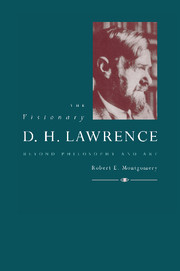Book contents
- Frontmatter
- Contents
- Acknowledgments
- 1 Introduction
- 2 Flesh, Word, and Holy Ghost: Lawrence and Schopenhauer
- 3 The passionate struggle into conscious being: Lawrence and Nietzsche
- 4 “A dry soul is best”: Lawrence and Heraclitus
- 5 The science of the soul: Lawrence and Boehme
- 6 Conclusion: Romanticism and Christianity
- Bibliography
- Index
5 - The science of the soul: Lawrence and Boehme
Published online by Cambridge University Press: 08 January 2010
- Frontmatter
- Contents
- Acknowledgments
- 1 Introduction
- 2 Flesh, Word, and Holy Ghost: Lawrence and Schopenhauer
- 3 The passionate struggle into conscious being: Lawrence and Nietzsche
- 4 “A dry soul is best”: Lawrence and Heraclitus
- 5 The science of the soul: Lawrence and Boehme
- 6 Conclusion: Romanticism and Christianity
- Bibliography
- Index
Summary
THE SUBTLE BODY
If one were forced to describe the thought of the later Lawrence in one word, that word would have to be “theosophical.” During the period from Women in Love to his death, the important new influences on him were theosophical, and his most important writings were based on ideas drawn from theosophical sources. His basic ideas did not change appreciably - in fact they were confirmed - but there is a distinct new emphasis and vocabulary as a result of a distinct new influence, which is theosophy. P. T. Whelan in his Myth and Metaphysic in “The Rainbow” and “Women in Love” says that “Lawrence lived at a time when occultism was a pervasive interest, almost a preoccupation among intellectuals” (103). Whelan thinks that Lawrence first became aware of theosophical and occult thought as early as 1908, but it was not until as late as 1917 that there are references to specific works that we know Lawrence read. The redoubtable Madame Blavatsky, founder of the Theosophical Society, was his chief source, although, as Tindall has documented in D. H. Lawrence and Susan His Cow, he was familiar also with other contemporary theosophists such as Annie Besant, Ouspensky, Gurdjieff, and Rudolf Steiner. His major philosophical works after “The Crown” are all consciously and explicitly theosophical. The psychology constructed by Lawrence in Psychoanalysis and the Unconscious and Fantasia of the Unconscious is based on the esoteric doctrine of chakras that he found in Blavatsky and in her friend James Pryse's The Apocalypse Unsealed.
- Type
- Chapter
- Information
- The Visionary D. H. LawrenceBeyond Philosophy and Art, pp. 168 - 217Publisher: Cambridge University PressPrint publication year: 1994



